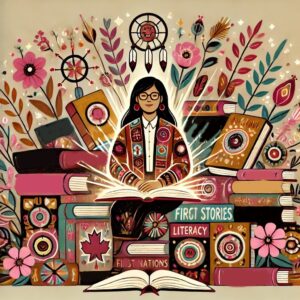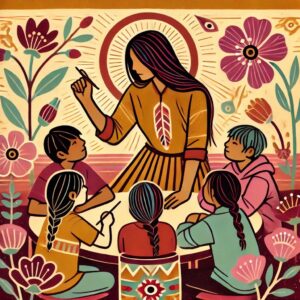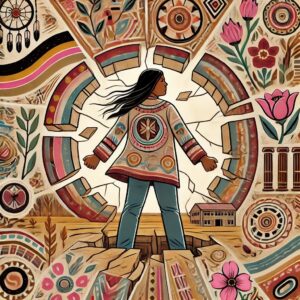Honouring Storytelling, Relationships, and Growth: My Teaching Philosophy Rooted in First Nations ways of knowing and Literacy
I believe teaching is more than the transmission of knowledge—it is an act of relationship-building, nurturing curiosity, honouring the voices of our learners and building teacher’s knowledge base in literacy. As a First Nations educator and literacy consultant, my teaching philosophy is deeply rooted in the traditions of my people, where learning happens through storytelling, shared experiences, and a deep respect for the interconnectedness of all things, as well as promoting the excellence of teachers.

DALL·E 2025-03-17 11.03.17
Storytelling as a Foundation for Learning
In First Nations cultures, storytelling has always been a powerful way to pass down knowledge, history, and values. Stories are not just entertainment; they are lessons woven with wisdom, offering guidance on how to live, how to relate to others, and how to understand the world. In my teaching, I integrate storytelling as a tool to help students connect with content on a personal and cultural level. Whether through oral narratives, picture books, or student-created stories, literacy becomes an avenue for self-expression and identity formation.
Literacy as a Path to Empowerment for Lifelong Learning
Literacy is more than the ability to read and write—it is the key to critical thinking, self-determination, and lifelong learning. In my role as a literacy consultant, I advocate for culturally responsive teaching practices that honour Indigenous (FNMI) perspectives, languages, and literacies. This means ensuring that Indigenous students see themselves reflected in the texts they read, the stories they hear, and the learning experiences they engage in. It also means aligning our teaching practices to meet the needs of our Indigenous learners first and foremost through understanding how the brain learns to read. (Science of Reading)

DALL·E 2025-03-17 11.03.30
It also means recognizing that literacy goes beyond conventional definitions; it includes the ability to interpret symbols, oral traditions, land-based knowledge, and digital literacies. My goal is to foster a love of literacy that extends beyond the classroom and empowers students to use their voices in meaningful ways.
Relationships and Holistic Growth
One of the core values in First Nations education is the belief that learning is relational. We do not learn in isolation; we learn through our connections to others—our families, our communities, and our ancestors. In my teaching, I prioritize building strong, respectful relationships with students, colleagues, and families. By fostering a sense of belonging, I create learning environments where students feel safe, valued, and encouraged to take risks in their learning. Through risk-taking and failure, that is where the learning occurs, their ability to get up and try again is what I wish for all the students I work with. My role as a literacy consultant means being a constant cheerleader to the students I work with.

DALL·E 2025-03-17 11.03.44
Holistic education means nurturing not just the mind, but the heart, body, and spirit. I strive to incorporate Indigenous ways of knowing and being into my practice, whether through land-based learning, experiential education, or social-emotional teaching strategies that recognize the whole learner.
Moving Forward: Decolonizing Education
Education has historically been a tool of colonization, but it also has the power to be a tool of resistance and healing. As an educator, I am committed to decolonizing literacy by centring Indigenous voices, challenging dominant narratives, and advocating for policies that support Indigenous students and educators. I believe that by embedding Indigenous perspectives into teaching and learning, we can create an educational system that honours the knowledge, resilience, and contributions of First Nations peoples.

DALL·E 2025-03-17 11.25.33
Conclusion
My teaching philosophy is a reflection of my identity as a First Nations educator and literacy advocate. It is rooted in storytelling, in the power of literacy, in the strength of relationships, and a vision for a more inclusive and just education system. By weaving together Indigenous traditions and contemporary literacy practices, I strive to create learning spaces where all students feel seen, heard, and empowered to reach their full potential.
My overall goal for any First Nation students I work with is for them to be able to walk in two worlds or “walk on both sides of the river”. I want to leave this video here for anyone to watch. It emphasizes the idea that “walking in two worlds” is possible but requires a lot of balancing and code-switching between their First Nation culture as well as the non-indigenous world where they also need to thrive.
Take a watch, and leave a comment below on what are you doing for reconciliation within your classroom. Are you allowing your FNMI students to thrive and “walk in two worlds”?
Hiy Hiy,
kinanâskomitin (thank you)

This post really resonated with me as an educator. The emphasis on storytelling, relationships, and supporting students in “walking in two worlds” aligns closely with what I aim to create in my classroom.
Storytelling has been such a powerful tool in my teaching. Whether exploring Indigenous creation stories or encouraging students to share their own experiences, I’ve seen how storytelling fosters deeper connections and a stronger sense of identity. It’s incredible to watch students engage more meaningfully when they see their own lives and cultures reflected in what they’re learning.
The focus on relationships is another piece that stood out to me. Creating a safe, supportive space where students feel valued has always been a priority in my teaching. When students trust their environment, they’re more willing to take risks, make mistakes, and grow — something I consistently strive to encourage.
The idea of helping students “walk in two worlds” is so powerful. As I reflect on my own teaching, I’m thinking about ways to better support my FNMI students in feeling confident in both their cultural identity and academic success. Incorporating diverse voices, promoting meaningful conversations, and inviting Indigenous perspectives into the classroom are steps I’m committed to continuing.
Reconciliation is an ongoing journey, and I know there’s always more to learn. I’d love to hear from others — what strategies have you found effective in creating space for all students to thrive?
Karissa
Thank you for being an Ally for FNMI students in your classroom. It is through teachers like yourself, and other non-first nations people out there, taking action against some of the oppressive structures in place today that we will see true reconciliation.
kinanâskomitin (thank you)